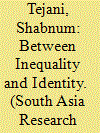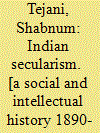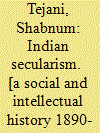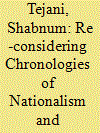|
|
|
Sort Order |
|
|
|
Items / Page
|
|
|
|
|
|
|
| Srl | Item |
| 1 |
ID:
124973


|
|
|
|
|
| Publication |
2013.
|
| Summary/Abstract |
Recent attention to the history of constitution-making in India reflects ongoing concerns about the difficulties and limitations of India's secular, democratic experiment. Scholars assessing India's secularism have pointed to the failure to separate the state from its involvement in religion from the outset. Through a study of the Constituent Assembly debates, this article suggests that the emphasis on 'religion' as the problem for secularism has been a distraction, taking the gaze away from the substantive arguments minorities were making about how their equal citizenship should be guaranteed. It remained unclear what recognition of 'minority' status was meant to achieve in postcolonial India and what it signified. In failing to recognise the claims of religious minorities for their equality, the Constituent Assembly reified their position as permanently unequal communities in the newly independent state.
|
|
|
|
|
|
|
|
|
|
|
|
|
|
|
|
| 2 |
ID:
083457


|
|
|
|
|
| Publication |
New Delhi, Permanent Black, 2007.
|
| Description |
xvii, 302p.
|
| Standard Number |
9788178242125
|
|
|
|
|
|
|
|
|
|
|
|
Copies: C:1/I:0,R:0,Q:0
Circulation
| Accession# | Call# | Current Location | Status | Policy | Location |
| 053882 | 320.540954/TEJ 053882 | Main | On Shelf | General | |
|
|
|
|
| 3 |
ID:
102406


|
|
|
|
|
| Publication |
Ranikhet, Permament Black, 2007.
|
| Description |
xvi, 302p.
|
| Standard Number |
9788178243121, hbk
|
|
|
|
|
|
|
|
|
|
|
|
Copies: C:1/I:0,R:0,Q:0
Circulation
| Accession# | Call# | Current Location | Status | Policy | Location |
| 055860 | 320.540954/TEJ 055860 | Main | On Shelf | General | |
|
|
|
|
| 4 |
ID:
079529


|
|
|
|
|
| Publication |
2007.
|
| Summary/Abstract |
In 1920, M.K. Gandhi launched the Non-cooperation campaign, his first attempt at mass anti-colonial mobilisation. It quickly became aligned with the Khilafat movement-a mobilisation among Indian Muslims to protect the position of the Khalifa after the defeat of the Ottoman Empire. Scholars have seen this moment as the high point of cooperation between India's Hindus and Muslims, with a real possibility for unity in the nationalist movement. However, the campaigns ended within two years and, after 1922, differences among the leadership intersected with violent conflicts between Hindu and Muslim communities in a number of different regions; the promise of the preceding years appeared shattered, some argue for ever. Scholarship on the Khilafat movement has been teleological, tending to read it either as part of the story of 'Muslim separatism' or subsuming it into the forward march of Indian nationalism.
Arguing that the picture drawn by the existing scholarship is misleading, this article asks if the Khilafat movement can really have a story of its own. Through examining the campaign in Sind, it shows that at the grassroots it was made up of a complex set of alliances, often little related with religious difference or Indian nationalism, made and broken right from its inception. Rather, it argues that political developments in the post-Khilafat period proved crucial to the way that nationalism and communalism would come to be defined
|
|
|
|
|
|
|
|
|
|
|
|
|
|
|
|
|
|
|
|
|